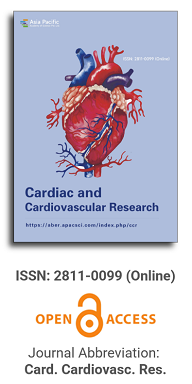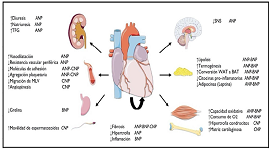
Asia Pacific Academy of Science Pte. Ltd. (APACSCI) specializes in international journal publishing. APACSCI adopts the open access publishing model and provides an important communication bridge for academic groups whose interest fields include engineering, technology, medicine, computer, mathematics, agriculture and forestry, and environment.

Cardiovascular pharmacological interventions are crucial for disease treatment. This issue explores innovative findings related to enhancing blood circulation and improving cardiac function through pharmacological agents, thereby opening new avenues for cardiovascular therapy.
Issue release: 30 June 2022
Objective: To evaluate the effects of Shensong Yangxin capsule, Qiliqiangxin capsule and Tongmai Yangxin Pill on the in vitro activities of four subtypes of rat liver microsomal CYP450 enzyme CYP1A2, CYP2C11, CYP2D1 and CYP3A1. Method: 15.04 μmol·L-1 caffeine, 4.98 μmol·L-1 omeprazole, 7.81 μmol·L-1 metoprolol and 6 μmol·L-1 midazolam is the specific probe substrate of CYP1A2, CYP2C11, CYP2D1 and CYP3A1 respectively. Three Chinese patent medicines against cardiovascular diseases are co incubated with the mixed probe substrate of four CYP450 enzyme subtypes in rat liver microsomes respectively. The remaining probe substrate in rat liver microsomes incubation system is measured by HPLC to calculate the inhibition percentage of corresponding enzyme activity and calculate the IC50 value. Results: compared with the blank group, the activities of sub enzymes decreased with the increase of the concentration of three drugs (P < 0.05); The IC50 values of three drugs on rat liver microsomal CYP1A2, CYP2C11, CYP2D1 and CYP3A1 were 1.896, 31.97, 12.37 and 1.357 respectively μmol·L-1; Qiliqiangxin capsule>100, 1.513, 35.2, 6.669 μmol·L-1; Tongmai Yangxin pill>100, 33.970, 0.566, 14.380 μmol·L-1 . Conclusion: Shensong Yangxin capsule has moderate inhibitory effect on CYP1A2 and CYP3A1, Qiliqiangxin capsule has moderate inhibitory effect on CYP2C11 and CYP3A1, Tongmai Yangxin pill has strong inhibitory effect on CYP2D1, and other effects are not obvious.
Issue release: 30 June 2022
Objective: To explore the intervention mechanism of short-term high-dose atorvastatin on atherosclerotic (as) plaque. Methods: 4-week-old male apoE-/- mouse were fed with high fat for 6 weeks to establish as model. They were randomly divided into control group, model group, atorvastatin conventional dose group, medium dose group and high dose group (load dose group and non load dose group). After 2 weeks, the blood lipid level, inflammatory factor concentration, platelet number, platelet membrane protein expression level and plaque area of each group were compared. Results: Compared with the model group, HDL-C increased significantly, LDL-C decreased significantly, the levels of inflammatory factors in serum and plaque decreased significantly, PLT decreased significantly, and the fluorescence intensity of CD31 and CD62p decreased significantly (all P < 0.05); The level of ox LDL in the load dose group was significantly lower than that in the model group (P < 0.05). The plaque area of atorvastatin intervention groups was significantly lower than that of model group (all P < 0.05). Conclusion: Short-term high-dose atorvastatin may intervene as by reducing blood lipid level, inhibiting the release of related inflammatory factors and regulating the number of platelets and the expression of platelet membrane protein.
Issue release: 30 June 2022
Objective: To investigate the risk factors of pancreatic fistula after resection of pancreatic body and tail duct adenocarcinoma. Methods: all cases of pancreatic body and tail resection for pancreatic body and tail duct adenocarcinoma in Union Hospital Affiliated to Tongji Medical College of Huazhong University of science and technology from January 2016 to December 2018 were analyzed retrospectively in a single center. The preoperative, intraoperative and postoperative data were collected and analyzed by spssv22.0. The definition and grouping of pancreatic fistula were implemented according to the standards formulated by the international pancreatic fistula research group in 2016. All cases were followed up for at least 3 months. Results: A total of 91 cases were included in the study. The overall pancreatic fistula rate was 25.27% (23/91). No death occurred within 90 days after operation. Three risk factors for pancreatic fistula were identified: Pancreatic texture (soft) [odds ratio = 8.965,95% confidence interval (2.400,33.490), p = 0.001], combined with cardiovascular disease [odds ratio = 9.148,95% confidence interval (1.936,43.225), p = 0.05], albumin <26.50g/l[odds ratio =6.100,95% confidence interval (1.846,20.157), p = 0.003]. Conclusion soft pancreas, complicated with cardiovascular disease and low albumin level on the first day after operation are independent risk factors for pancreatic fistula after operation of pancreatic duct adenocarcinoma. Due to the limitations of the study, the results need to be further verified.
Issue release: 30 June 2022
Objective: To systematically analyze the effect of Panaxadiol on gene expression of cardiac microvascular endothelial cells (cmecs) during lipopolysaccharide (LPS) infection. Methods: by isolating primary cmecs from rats, the cells were divided into control group and experimental group. The control group was stimulated by LPS alone, and the experimental group was stimulated by LPS and Panaxadiol together. After that, the differentially expressed genes and related signal pathways were analyzed by transcriptome sequencing, and some differentially expressed genes were verified by quantitative PCR. Results: Panaxadiol could significantly inhibit the expression of some genes, which were mainly concentrated in inflammatory signal related pathways, metabolic related pathways and epigenetic regulation. Conclusion: Panaxadiol may affect the expression of inflammation related genes through epigenetic regulation, and then regulate the inflammatory response of cmecs.
Issue release: 30 June 2022
Objective: To investigate the effect of sodium creatine phosphate on myocardial and left ventricular function in patients with slow / no reflow acute ST segment elevation myocardial infarction (STEMI) during percutaneous coronary intervention (PCI). Methods: The incidence of major adverse cardiovascular events (heart failure, recurrent myocardial infarction, malignant arrhythmia, cardiac arrest, cardiogenic shock, etc.) Was recorded and compared between the two groups. Results: Conclusion sodium creatine phosphate can reduce myocardial injury, improve heart rate variability and left ventricular function, and reduce the risk of major adverse cardiovascular events in STEMI patients with slow / no reflow during PCI.

Prof. Prakash Deedwania
University of California,
San Francisco, United States





 Open Access
Open Access